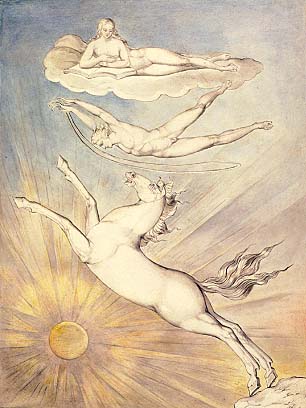 Pen, ink and watercolor, approximately 9 x 6.5 inches. The British Museum, London.
Blake's Fiery Pegasus is one of six illustrations commissioned by Joseph Thomas for his copy of the second folio of Shakespeare's plays.
Pen, ink and watercolor, approximately 9 x 6.5 inches. The British Museum, London.
Blake's Fiery Pegasus is one of six illustrations commissioned by Joseph Thomas for his copy of the second folio of Shakespeare's plays.
 Pen, ink and watercolor, approximately 9 x 6.5 inches. The British Museum, London.
Blake's Fiery Pegasus is one of six illustrations commissioned by Joseph Thomas for his copy of the second folio of Shakespeare's plays.
Pen, ink and watercolor, approximately 9 x 6.5 inches. The British Museum, London.
Blake's Fiery Pegasus is one of six illustrations commissioned by Joseph Thomas for his copy of the second folio of Shakespeare's plays.
The inspiration for the picture comes from The First Part of Henry IV, Act IV, Scene i, where Sir Richard Vernon at the Battle of Shrewsbury comments on the sudden transformation of Prince Hal into a soldier who "vaulted with such ease into his seat / As if an angel dropp'd down from the clouds/ To turn and wind a fiery Pegasus/ And witch the world with noble horsemanship."
Blake entitled the picture "A spirit vaulting from a cloud to turn and wind a fiery Pegasus"; to this title he adds a gloss which W. M. Merchant suggests typically "weds the Shakespearean theme to his own mythology": Blake says that in his illustration "The Horse of Intellect is leaping from the cliffs of Memory: it is a barren Rock: it is also called the Barren Waste of Locke and Newton." Here, Merchant comments, the barren reason that Blake rejects is supplanted by creativity and spontaneity (Apollo 320).